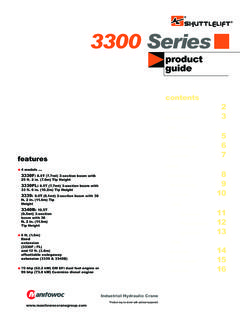Transcription of 078-31: Efficient Construction of a “One-Row-per-Subject ...
1 1 Paper 078- 31 efficient One-Row-per-Subject Data Mart Construction for Data Mining Gerhard Svolba, PhD, SAS Austria ABSTRACT Creating a "one-row-per-subject" data mart is a fundamental task when preparing data for data mining. To answer the underlying business question, the analyst or data-mart programmer is challenged to distill the relevant information from various data sources. Creating a data mart involves more than reading columns from a source table to the data mart. It also includes the aggregation or transposition of observations from "multiple-row-per-subject" tables like transactional tables and time histories. This process is a critical success factor for being able to answer the business question or to have good predictors available for a target event or target value.
2 This paper shows the details of input data structures for a "one-row-per-subject" data mart. It also discusses the "one-row-per-subject" paradigm from a technical and a business point of view, and shows how data, some of which include hierarchical dependencies, is aggregated into a single-row-per-subject. A comprehensive example shows how a "one-row-per-subject" data mart is created from various data sources. INTRODUCTION Besides selecting and tuning the appropriate statistical model, data availability and data preparation are fundamental to the successful performance of an analytical model. Depending on the business questions and on the properties of the statistical model, different data mart structures, like the one-row-per-subject data mart that is necessary for predictive modeling or the multiple-row-per subject data mart that is required for market basket analysis, must be assembled.
3 Answering a business problem usually includes the following steps: 1. Define the business problem. A lot of collaboration and discussion between business people, analysts, and IT people is needed in order to evaluate what exactly is needed. 2. Based on the definition of the business problem, determine what data is available to help you answer the business question(s), particularly observational data rather than data that are specifically gathered for an analysis. 3. Determine how to prepare the data for analytical modeling and the analytical data mart. 4. Feed the analytical data mart into the analytical procedure to analyze relationships, predict values and events, or segment subjects, to name a few tasks. There are two main factors that influence the quality of an analytical model: The selection and tuning of the appropriate analytical model The availability and preparation of data that is suitable to answer the business question.
4 SUCCESS FACTORS FOR ANALYTICS In statistical theory and literature there is much focus on the selection and tuning of an analytical model. There are many books and courses that focus on predictive modeling--training neural networks, creating decisions trees, or building regression models. For all these tasks a lot of knowledge is needed and has proven to be a critical success factor for good analytical results. Besides the importance of analytical skills, however, having good and relevant data to help answer business questions is also very important. Data Mining and Predictive ModelingSUGI31 2 SUCCESS FACTORS FOR DATA The availability of the data for creating the analytical data mart is an important consideration to evaluate early in a project. Determining whether historic snapshots of the data that are necessary for an analysis will be available is a long-term planning issue and is not something that can be determined at the beginning of the data preparation process.
5 The adequate preparation of the data is an important success factor for analysis. Even if the right data sources are available and can be accessed, appropriately preparing the data is an essential pre-requisite for a good model. In the author s experience with numerous projects, a missing or improperly derived variable or aggregation cannot be covered up by any clever parameterization of the model. This paper focuses on the adequate preparation of the data. This paper contains the content of selected chapters from a soon to be released book Data Preparation for Analytics written by Gerhard Svolba (read more about this book in the section Recommended Reading ). Following is a discussion of conceptual relationships and data structures when creating a one-row-per-subject data mart.
6 The creation process is further illustrated by a case study. THE ONE-ROW-PER-SUBJECT PARADIGM ANALYSIS SUBJECT Analysis subjects are entities that are being analyzed and the analysis results are interpreted in their context. Analysis subjects are therefore also the basis for the structure of analysis tables. Examples of analysis subjects are: Persons: Depending on the area of the analysis the analysis subjects have more specific names like patients in medical statistics, customers in marketing analytics, or applicants in credit scoring. Animals: Piglets, for example, are analyzed in feeding experiments; rats are analyzed in pharmaceutical experiments. Parts of the body system: In medical research analysis subjects can also be parts of the body system like arms (left arm compared to the right arm), shoulders or hips.
7 Note that from a statistical point of view the validity of the assumptions of the respective analysis methods have to be checked, if dependent observations per person are used in the analysis. Objects: Things like cash machines in cash demand prediction, cars in quality control in the automotive industry, or products in product analysis can be subjects. Legal entities: Examples are companies, contracts, accounts, and applications. Geography: Regions or plots in agricultural studies or reservoirs in the maturity prediction of fields in the oil and gas industries are examples. Analysis subjects are therefore the heart of each analysis. The features of analysis subjects are measured, processed, and analyzed. In deductive statistics the features of the analysis subjects in the sample are used to infer the properties of the similar subjects in the larger population.
8 IMPORTANCE AND FREQUENT OCCURRENCE OF THIS TYPE OF DATA MART The one-row-per-subject data mart is important for statistical and data mining analyses. Many business questions are answered based on a data mart of this type. The following list presents business examples: Prediction of events such as - Campaign response - Contract renewal - Contract cancellation (attrition or churn) - Insurance claim - Default on credit or loan payback - Identification of risk factors for a certain disease Prediction of values such as - Amount of loan that can be paid back - Customer turnover and profit for the next period - Time intervals like the remaining lifetime of a customer or patient Data Mining and Predictive ModelingSUGI31 3 - Time until next purchase - Value of next insurance claim Segmentation of customers The following analytical methods require a one-row-per-subject data mart.
9 Regression analysis Analysis-of-variance analysis Neural networks Decision trees Survival analysis Cluster analysis Principle components analysis and factor analysis PUTTING ALL INFORMATION INTO ONE The above application examples coupled with the underlying algorithm requires that all the data source information be aggregated into one row. Central to this type is the fact that we have to put all information per analysis subject into one row. We will therefore call this the one-row-per-subject data mart paradigm in that all information has to be put into a single row. Multiple observations per analysis subject must not appear in additional rows, but have to be converted over into additional columns. Obviously, putting all information into one row is very simple if we have no multiple observations per analysis subject.
10 The values are then simply read into the analysis data mart and derived variables are being added. If we have multiple observations per analysis subject it is more effort to put all information into one row. Here we have to cover two aspects: The technical aspect--how multiple-row-per-subject data can be converted into one-row-per-subject data. The business aspect--which aggregations, derived variables, and so on can best be condensed from the multiple rows into columns. The process of taking data from tables that have one-to-many relationships and putting them into a rectangular one-row-per subject analysis table has many names: transposing, denormalizing, making flat , pivoting, and others. Figure 1 illustrates the creation of a one-row-per-subject data mart in terms of an entity relationship diagram.












